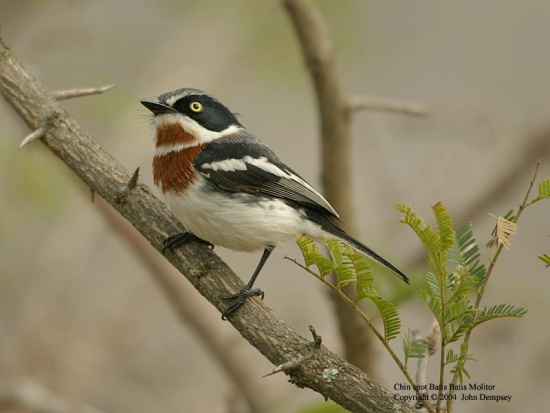Alternative names, White-flanked Batis, Chinspot Puffback-Flycatcher
- Batis molitor
Identification
Length 12-13 cm; mass 8-14 g
Differs from other Batis species by its pure white flanks (and the chestnut breast band and throat patch in the female).
Distribution
Sub-Saharan Africa
Western Africa: Gabon, DRC and Angola
Eastern Africa: Sudan, Kenya, Uganda, Rwanda, Burundi, Tanzania, Zambia, Mozambique and Malawi
Southern Africa: Namibia, Botswana, Zimbabwe, South Africa, KwaZulu-Natal, Lesotho and eSwatini
Taxonomy
Subspecies
Batis molitor has four subspecies:1
- B. m. pintoi
- B. m. puella
- B. m. palliditergum
- Southern Zaire to Namibia, Botswana, Malawi and north-western South Africa
- B. m. molitor
- Southern Mozambique to eastern South Africa
Habitat
Woodland, savanna and riverine thickets.
Behaviour
Active birds; constantly foraging and hawking insects and spiders in the canopy of trees or bushes.
Breeding
The nest is a small cup of plant fibres and spider web, decorated with lichen; built by both sexes on a horizontal branch. One to four eggs are laid and incubated for 16-18 days by the female. Both adults feed the young.
References
- Clements, JF. 2009. The Clements Checklist of Birds of the World. 6th ed., with updates to December 2009. Ithaca: Cornell Univ. Press. ISBN 978-0801445019.
- Gibbon G. 2002. Roberts' Multimedia Birds of Southern Africa: Version 3. John Voelcker Bird Book Fund. www.sabirding.co.za
Recommended Citation
- BirdForum Opus contributors. (2025) Chinspot Batis. In: BirdForum, the forum for wild birds and birding. Retrieved 3 May 2025 from https://www.birdforum.net/opus/Chinspot_Batis
External Links
GSearch checked for 2020 platform.1





